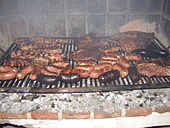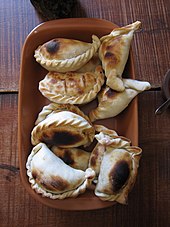Argentinian cuisine
The Argentine cuisine is influenced by both the kitchen of different countries in Europe as well as the geographical characteristics of the country.
The widespread cattle breeding in the Pampa region in particular led to a high proportion of beef in the dishes. There are also dishes that were brought to Argentina by immigrants from Europe, especially from Italy ( pizza , pasta ). The Northwest region has its own cuisine, with dishes based on corn and rice , a stronger use of spices and generally more piquant preparation methods.
Food
Asado

An asado is a typical national grill meal. It often forms the Sunday meal in the extended family or with friends. Each Asador ("grill master") has his own way of preparing grilled food. Grilling often takes several hours and is a small social event.
The ingredients consist of everything a beef, sheep or pork has to grill. The classic ingredients in the Buenos Aires area are various types of meat such as matambre (pork or veal belly), tira de asado (flat rib), bife de chorizo ( rump steak ) and lomo (loin) as well as chorizo (sausages), morcilla (blood sausage) and various organ meats, such as Chinchulines (intestines), riñones (kidney) or Molleja ( sweetbreads ). However, there are no limits to the choice of ingredients. Chimichurri (sauce) is often eaten with grilled meat . The oil that has settled above the sauce is poured onto the meat before grilling or while it is grilling. The pesto-like base is eaten with meat or with white bread during grilling. Used oil can be refilled within limits.
In Patagonia , lamb is usually used instead of beef, as it is cheaper there than beef.
The side dishes are usually only light salads, white bread and red wine .
Empanadas
The empanadas are crescent-shaped or round dumplings with different fillings (minced meat, ham / cheese, corn, vegetables, etc.). They are both baked and deep-fried. The province of Salta in particular is known for the fried empanadas. They are usually eaten as a starter or as a snack between meals. A specialty are the empanadas Árabes in Córdoba, which are triangular and without a layer of pastry and are refined with lemon. There are also several chains in the larger cities that sell empanadas as fast food.
Stews
There are various stews in Argentina that are very traditional and popular, especially in working class kitchens. The most important are Locro , Puchero and Guiso .
The Locro is a stew from northern Argentina. It consists of a wide variety of ingredients, mainly corn kernels, various types of sausages, pieces of meat and pumpkin. It is usually very spicy. Locro is traditionally eaten on May 1st and the national holidays of Argentina (May 25th, July 9th), where in some cities the Locro is distributed free of charge in the center.
A puchero is a vegetable and meat stew that is popular across Argentina. It usually contains the following ingredients: potatoes , sweet potatoes , pumpkin , carrots , pieces of meat ( ossobuco ), Swiss chard and eggs .
Guisos are stews that use either pasta or rice as a base and are usually cooked in tomato sauce. The guiso de mondongo , in which the beef stomach ( mondongo ) is the main ingredient, is particularly traditional . There are also Guisos with other types of beef and those with chicken.
Italian influenced dishes
Due to the high proportion of Italian immigrants, Italian cuisine is very widespread in Argentina. However, the dishes have often been modified a little over time.
In Argentina , for example, an independent variant of the pizza is produced. B. Fugazzeta . Characteristic are the large size of the pizza, the thickness of the dough, as well as the thick layer of side dishes and cheese, which distinguish the Argentine pizza from the Italian variant.
Pasta is also very popular. In contrast to Italy, the pasta tends to be cooked longer and is therefore softer. The range of pasta ranges from Tallarines , tagliatelle , fusilli and Mostacholes, to name a few of the pasta variations, over half-moon-filled specialties like tortellini , cappelletti and Tortelleti to square filled variants such as ravioli (large), Sorrentini (larger) and Panzoti (the biggest). There are no limits to the taste of the fillings. A special variant is a one-noodle dish, consisting of a giant panzoti and a sauce.
Flan
Flan is a vanilla- flavored egg pudding that is served with a dark caramel sauce and dulce de leche (caramelized milk) or membrillo (quince jelly) for dessert.
Fast food
Argentina has its own variant of American-style sandwiches . Typical Argentine sandwiches are primarily: choripán , a bread with a sausage (chorizo), lomito , a sandwich with a thin slice of sirloin, and the sandwich de milanesa , a schnitzel roll . Hamburgers and hot dogs (called pancho ) are very popular, they are prepared the same way as in the USA. There is also the chimichurri , a spice mixture in oil with a piquant taste. There are also the so-called sandwiches de miga which are available in different versions and consist of very thin white bread. The most common is with cheese and ham.
beverages
Mate tea
National drink of Argentina is also in the neighboring countries Uruguay and Paraguay popular mate tea . It is supposed to take away the feeling of hunger and has a stimulating effect due to its caffeine content. The mate is drunk in a calabash with a tube, the bombilla , and the mate is shared at social gatherings. A cold variant is the tereré , in which the yerba (crushed tea leaves) is not infused with hot water, but with cold juice or lemonade.
Wine

Wine is also grown in Argentina. The growing areas are mainly in the west of the country.
See also: Viticulture in Argentina
beer
The Argentine beer market is controlled by a few companies. By far the most popular is lager , which is offered by numerous companies ( Quilmes , Isenbeck , Brahma etc.); other types of beer only occupy niche markets and are often only sold by small breweries.



